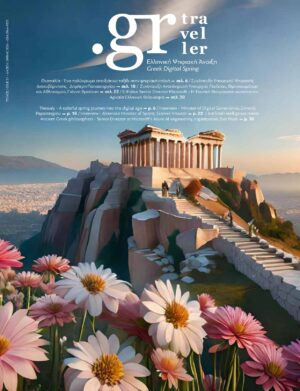The once dilapidated old primary school of Kampos in Tinos, embraces the works of an important Greek artist, Kostas Tsoklis, for the last decade.

With the director, Mrs Chrysanthi Koutsouraki, as our “guide”, we explored a space full of images that “escape” the boundaries of the canvas. They grow, grow taller, stretch out, move with the help of technology and create living works that “trigger” intense emotions and thoughts.
In the first room we see the artist’s recent works, with a sense of melancholy, which he created last winter. In this area, in fact, as Mrs Koutsouraki tells us, she had made the blueprints.
We continue in the space where the artist himself writes the texts about his life and art. When it functioned as a school, it was the teacher’s room. “Some people come and don’t go inside because they remember the beating they got,” the director tells us. One year, a portrait of his mother was placed in this place. This year, they’re thinking of putting the
The Wayfarer
, a landmark work in live painting, in which Kostas Tsoklis is considered a pioneer. The artist is depicted as being on a continuous march, holding a red suitcase. He was inspired when he was travelling from Brussels to Paris by train. He thought that if he got off the train at that moment, he would want to have with him only his red suitcase with his memories, his obsessions and his dreams from which he could never get rid of, explains Ms Koutsouraki. In 1986 he represented Greece at the Venice Biennale, with his sensational work, the
The Stranded Fish
and the five portraits.

The walls are adorned with texts that he himself wrote about his art, choosing a representative work for each period, so that the visitor can get a brief overall picture of his artistic career.
Then we see the objects/performances that made him famous in Europe and many other important works – milestones in his artistic career, such as his tribute to
Sea
as he remembers it.
On the upper floor of the Museum, his work “Diadromia“, developed in the first log cabin, is on display. The figure of the artist at various stages of his life is highlighted. What people inspired him, supported him. One of the canvases shows his wife Eleni. A huge stone, representing art, is at the centre of a series of illustrations. Towards the end, we see the artist inside the stone, which proves that art is his own self.















